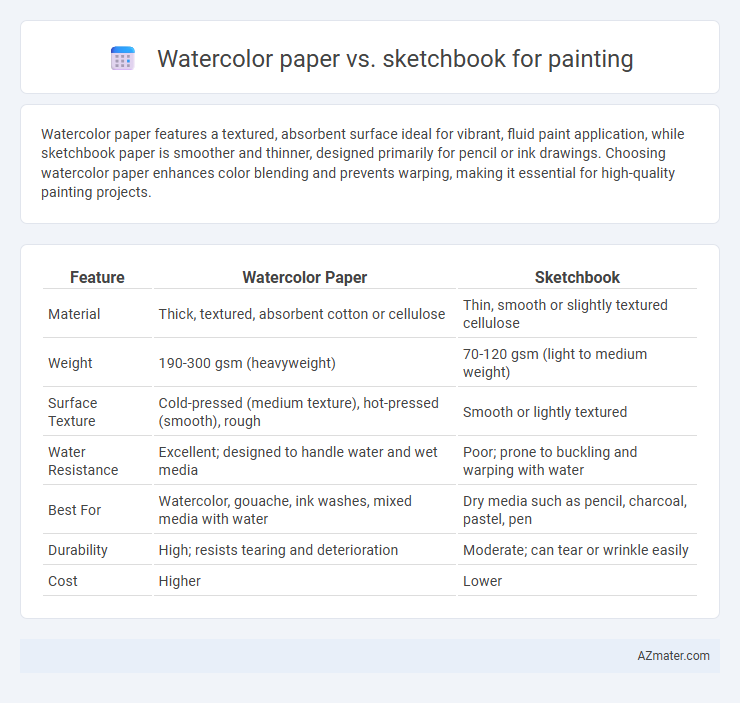Watercolor paper features a textured, absorbent surface ideal for vibrant, fluid paint application, while sketchbook paper is smoother and thinner, designed primarily for pencil or ink drawings. Choosing watercolor paper enhances color blending and prevents warping, making it essential for high-quality painting projects.
Table of Comparison
| Feature | Watercolor Paper | Sketchbook |
|---|---|---|
| Material | Thick, textured, absorbent cotton or cellulose | Thin, smooth or slightly textured cellulose |
| Weight | 190-300 gsm (heavyweight) | 70-120 gsm (light to medium weight) |
| Surface Texture | Cold-pressed (medium texture), hot-pressed (smooth), rough | Smooth or lightly textured |
| Water Resistance | Excellent; designed to handle water and wet media | Poor; prone to buckling and warping with water |
| Best For | Watercolor, gouache, ink washes, mixed media with water | Dry media such as pencil, charcoal, pastel, pen |
| Durability | High; resists tearing and deterioration | Moderate; can tear or wrinkle easily |
| Cost | Higher | Lower |
Understanding Watercolor Paper: Key Features
Watercolor paper features a textured surface designed to absorb water and pigments effectively, preventing warping and ensuring vibrant color retention. Its weight, typically ranging from 140 lb (300 gsm) to heavier options, provides durability and supports multiple layers of paint without bleeding. Unlike sketchbooks with thinner, smoother paper ideal for dry media, watercolor paper's fiber content and sizing make it essential for successful watercolor techniques.
What Makes a Sketchbook Suitable for Painting?
A sketchbook suitable for painting features heavyweight, acid-free paper with a textured surface that can absorb water and pigment without warping or bleeding. The paper's thickness, often measured in gsm (grams per square meter), ideally ranges from 140 gsm to 300 gsm to support various wet media, including watercolors and acrylics. Durability, smoothness, and the ability to maintain color vibrancy are critical factors that distinguish painting-oriented sketchbooks from standard drawing pads.
Texture Differences: Cold Press vs Sketchbook Paper
Cold press watercolor paper features a textured surface with a slightly rough, pebbled finish that enhances pigment absorption and allows for rich color layering, making it ideal for watercolor techniques. In contrast, standard sketchbook paper is usually smoother and less absorbent, designed for dry media like pencil or charcoal, which can cause watercolor paint to pool or warp the paper. Choosing cold press paper over sketchbook paper ensures better stability, color vibrancy, and texture interaction essential for professional watercolor painting.
Water Absorption and Paint Flow Comparison
Watercolor paper features high water absorption capacity, allowing pigments to spread evenly without warping, which enhances smooth paint flow and vibrant color blending. In contrast, sketchbook paper typically has lower absorbency, often leading to uneven paint distribution and potential buckling when wet. Artists seeking controlled paint flow and rich pigment saturation prefer watercolor paper over sketchbooks for wet media techniques.
Durability and Resistance to Warping
Watercolor paper is designed with thicker fibers and a higher weight, typically ranging from 140 lb (300 gsm) to 300 lb (640 gsm), which enhances durability and resistance to warping under heavy washes. Sketchbooks generally use lighter weight paper, around 50-80 lb (74-120 gsm), making them more prone to buckling and less suited for wet media applied in multiple layers. The sizing on watercolor paper further prevents water absorption, maintaining the structural integrity of the sheet during prolonged painting sessions.
Portability: Sketchbooks vs Loose Watercolor Sheets
Sketchbooks offer superior portability by combining multiple sheets in a bound format, making them easy to carry and use on the go without losing or damaging individual pages. Loose watercolor sheets provide more flexibility for larger or mixed media projects but require additional storage solutions like folders or portfolios to remain organized and protected during transport. Artists seeking convenience and compactness often prefer sketchbooks, while those prioritizing versatility and paper quality may opt for loose sheets despite increased bulk.
Price Comparison: Cost Per Page
Watercolor paper typically ranges from $0.50 to $2.00 per sheet due to its heavier weight and textured surface, designed to absorb water and pigment effectively. Sketchbook paper, often thinner and less specialized, usually costs between $0.10 and $0.50 per page, making it more budget-friendly for everyday practice but less suited for wet media. Choosing between the two depends on balancing the quality needs of watercolor techniques against the cost-efficiency sought in sketchbook usage.
Versatility for Different Mediums
Watercolor paper offers optimal surface texture and absorbency for watercolor paints, making it ideal for wet media techniques. Sketchbooks provide a versatile, multi-purpose option suitable for dry mediums like pencil, charcoal, and pen, but often lack the thickness and texture needed for heavy washes or wet applications. Artists seeking adaptability for mixed media may prefer heavyweight sketchbooks with textured pages or specialized watercolor pads to accommodate various painting styles.
Long-Term Preservation of Artwork
Watercolor paper, typically made from 100% cotton and designed with high acidity levels, offers superior long-term preservation by resisting yellowing and deterioration over time. Sketchbooks often use lower-quality, acidic paper that can cause fading, discoloration, and damage, making them less ideal for archival artwork. For artists focused on longevity and maintaining the vibrancy of their paintings, investing in professional-grade watercolor paper is essential to ensure durability and preservation.
Choosing the Right Surface for Your Artistic Goals
Watercolor paper offers a textured surface designed to absorb water and pigment, ideal for vibrant washes and detailed blending, while sketchbooks typically feature smoother, thinner pages suited for dry media like pencils and ink. Selecting the right surface depends on your artistic goals--watercolor paper enhances color retention and prevents warping for fluid painting techniques, whereas sketchbooks enable quick studies and layering without bleed-through. Prioritize paper weight, texture, and absorbency to match your preferred mediums and achieve the desired visual effects in your artwork.

Infographic: Watercolor paper vs Sketchbook for Painting
 azmater.com
azmater.com